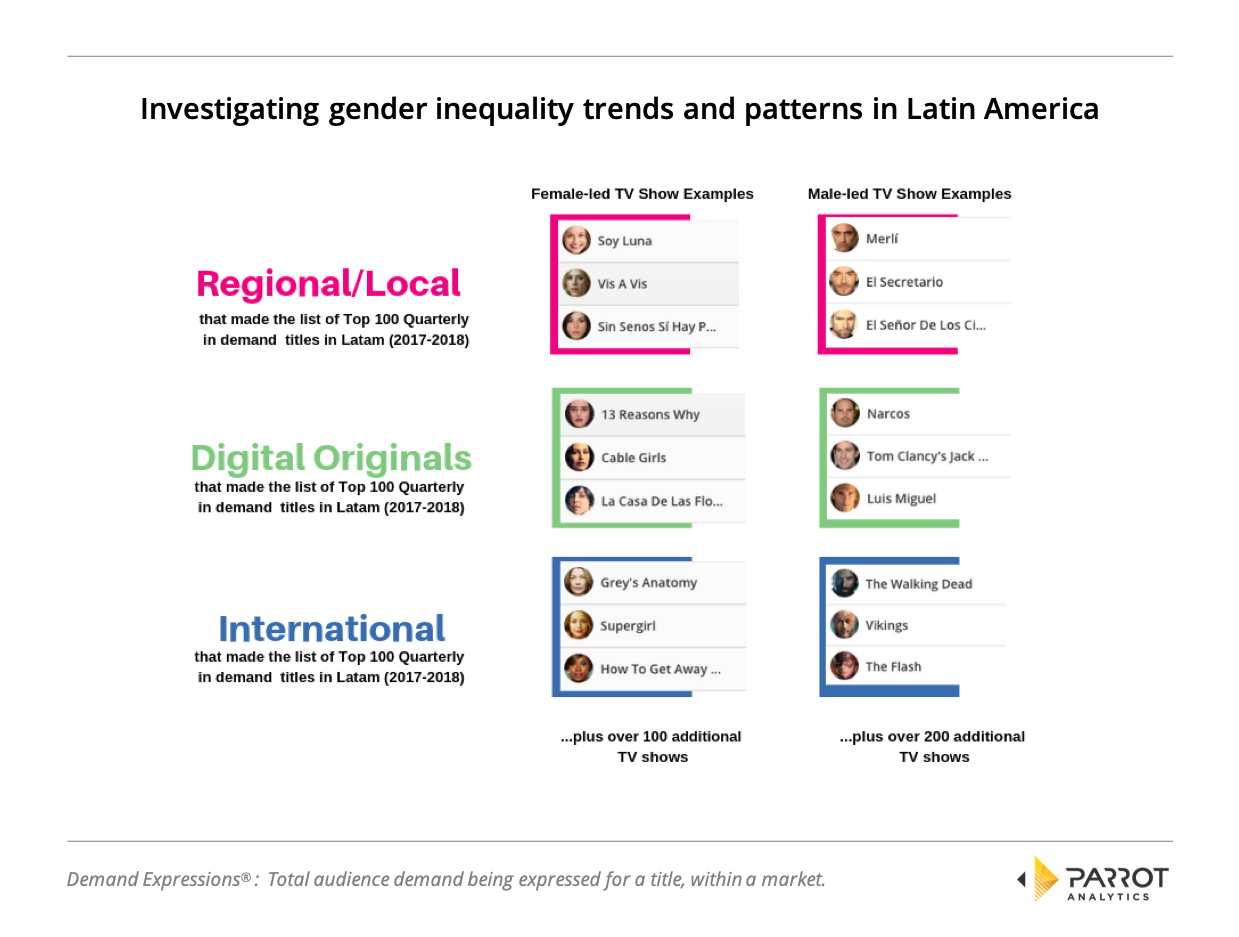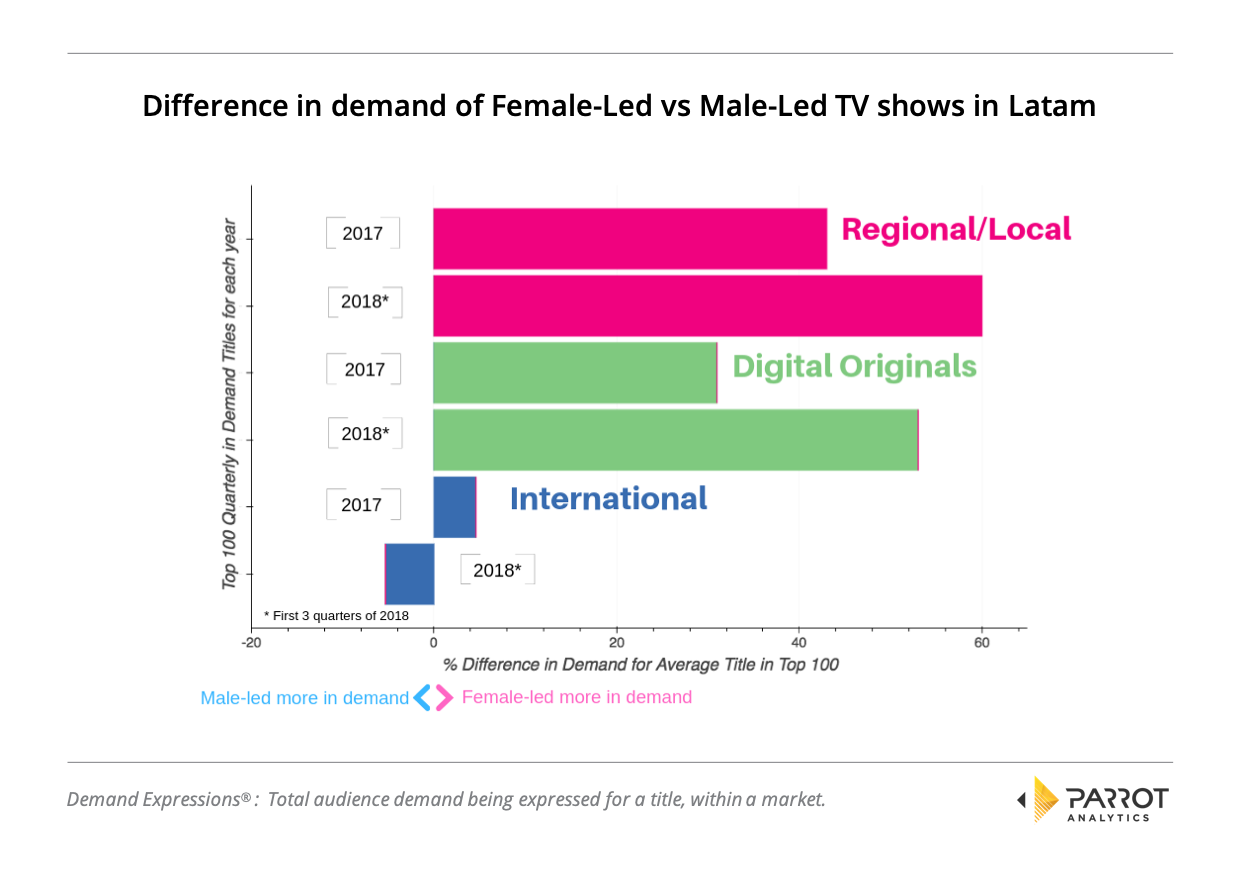Image: Supergirl, CW
It is fair to say that the television industry still has an ongoing issue with gender inequality. Although awareness of the issue has sparked productive conversations and positive changes, women are not yet represented equally, both behind the camera and in front of it.
The latter inequality is readily observed with global TV demand data: The highest-profile titles – those with the most demand from global audiences and thus the titles with the biggest influence on the culture of the world – star male leads nearly three times as often as female leads.
We were curious to discover if the male dominance of content is indeed on the decline since events over 2018 may have inspired more discussion about the power inequalities within the entertainment business. There are many individual high-profile titles that were hits in this timeframe that are anchored by the performance of a woman, such as the multiple award-winning comedy The Marvelous Mrs. Maisel or the breakout Spanish hit Money Heist/La Casa De Papel, which is narrated by a woman. However, is there a general trend to that effect?
Analysis of global trends
To find out the answer, let us first review the gender profile for a small subset of our catalog of over ten thousand titles we currently track that have topped our global chart across 100+ countries.
Classifying the top 25 titles in the world by male-led, female-led or neither, let us consider the ratio of female-led to male-led titles by quarter of 2018 to get a high-level overview of any change in the gender ratio at the very highest level of shows.
We found that titles that are male-led, such as Lucifer, do still outnumber titles that are female-led such as Grey’s Anatomy. Our analysis also uncovered the slightest change towards female-led titles increasing: The world’s top 25 shows by demand in Q3 had one additional female-led title compared to Q1 and Q2.
Note that this top 25 excludes titles classified “neither” where there is no apparent male or female lead, for example Game Of Thrones with its large ensemble cast.
To get a more complete picture of how widespread this trend is within the industry, we decided to investigate gender inequality in detail for a single region – Latin America – whilst also considering a longer timeframe for our analysis.
Investigating gender inequality trends and patterns in Latin America
Concentrating only on the Mexican, Argentinian, Colombian and Brazilian markets to get a representative flavor of Latin America, we decided to break out the most in-demand titles into the following three categories (that may concurrently apply):
- International titles: These are linear tv shows that were created outside the region but are much in demand in Latin America as well as the rest of the world. Examples of this group include blockbusters like The Walking Dead and Vikings and superheroes series like The Flash and Supergirl, as well long-standing hits such as the Big Bang Theory and Grey’s Anatomy.
- Digital originals: These are TV shows that were originally aired on SVOD platforms like Netflix or Amazon.
- Regional and local titles: These titles include Spanish-speaking content created in Latin America, US Hispanic, or Spain itself, as well as Brazilian-made shows.
Looking back at the first quarter of 2017 and, for each quarter after it, we identified the top 100 in-demand shows for each grouping in each of the representative countries as a way to get a quick understanding of the kind of content that is top-of-mind with Latin American audiences. We then proceeded to identify titles that were female-led as well as those that were male-led.
The following chart summarizes our methodology:
Our findings indicate female-led content from regional or digital origin is increasingly gaining prominence among the top 100 titles. For instance, back in 2017 only one digital or regional production with a female lead role made it to the top of the preferences for every two with a male lead role.
In-demand female-lead shows are moving towards parity in Latin America
This year, we found that when it comes to regional content in Latin America, female-led shows are now three-quarters of the way to reaching full parity with male-led shows. When it comes to digital, they’re about 60% of the way there.
This accelerating traction is not observed for international titles which remain in a proportion that is less favorable for women-centric storylines. International content that tops demand in Latin America exhibits a proportion closer to three male-led shows for every female-led show; this ratio seems to be fairly stable.
Consumer appetite for regional and digital content paints a different picture. Regional or digital women’s stories are not only escalating positions in the ranks of popularity but also generating deeper engagement.
In fact, in 2018, regional or digital titles that had females in lead roles attracted, on average, over 50% more demand than those that had males in lead roles. In contrast, average demand observed for any international title was not significantly different when comparing titles across different lead gender roles.
Measuring, monitoring and anticipating how societal catalysts spread around the world impacting on TV consumers’ habits and preference unlocks opportunity for those who pick up and capitalize on the signals early.







